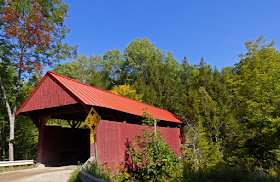Our final waterfall was Sterling Falls, part of the Sterling Falls Gorge Natural Area, a conservation area acquired from the family of IBM's Tom Watson and maintained by six different conservation organizations in Vermont. There are several hiking trails, but the most popular, I would guess, leads to the gorge and has the added attraction of interpretive signs. Since Dick and I are involved with such interpretation we really appreciated them. If I could find a way to contact the right group, I would let them know. All week, I've wished we had a geologist along. Somehow, I'd always thought Vermont was full of granite, and not much else. Internet research shows this is absolutely wrong, but I still would appreciate more guidance.
For example, did you know that a gorge consists of a series of moderate-sized falls, cascades, and pools. A gorge is a section of a stream channel with continuous rock walls which are at least 10 feet high on both sides. A small gorge has walls under 40 feet high and a large gorge has walls over 40 feet high. The walls at Sterling Falls Gorge range from as low as 11 feet at the northern end to over 50 feet at the southern end. Several falls and cascades occur at Sterling Falls Gorge Natural Area. The difference between the two is distinguished by how the water falls from the bedrock exposure. A falls is a vertical or near vertical drop which is at least 3 feet high. The water shoots outward and falls without touching the rock. A cascade is a bedrock exposure which is not vertical but at either a high or a low angle and the water remains in contact with the bedrock. A small falls or cascade is under 20 feet and a large one is over 20 feet.
Some of the fallen rocks are in fact large slabs of fallen wall but others were transported when the stream had much more energy. Perhaps in the spring, during the snowmelt season, the stream's discharge was at a much greater volume. The measure of a stream's ability to transport a certain maximum grain size of sediment is referred to as a stream's competence. Looking at the wide variety of sizes of material in Sterling Brook, it is obvious that its competence varies greatly with the season.
How do you think schistosity affects the credibility of the rock? Is it more credible with vertical or horizontal schistosity? The schisosity is a plane of weakness in the rock. It allows water to penetrate and more easily erode the rock than if it were a more homogenous "harder" rock. I love learning new vocabulary! You think of rocks being hard, but "credible?"
While watching Vermont PBS in the evening this week, we heard they were offering a special activity for their members at Smugglers' Notch Resort this Saturday, including a visit from the Vermont Institute of Natural Science - VINS - which rehabs raptors along with many other things. Well, I couldn't pass that by, could I? The presenter did a marvelous job, and it's always reassuring to hear someone else echo the things we always say about raptors. She even told the story about Kestrels being able to track mice because they can see mouse pee glowing in ultraviolet light, which they are able to see!







This was the most remote and off-the main road we were in a state that is rated the most rural of all the states. Beautiful the entire trip
ReplyDelete